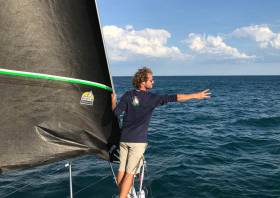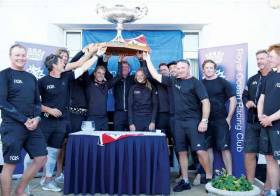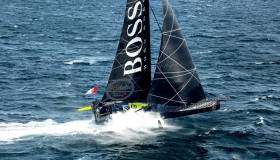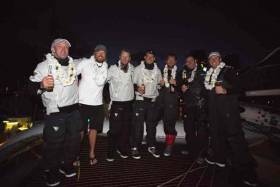Displaying items by tag: Justin Slattery
Justin Slattery's Seven Strong Irish Crew on 100ft Galateia are "Sailors of the Month (Superyachts)" for September
A crew with some of Ireland's top big boat talent are the deserved winners of the September Sailor of the Month Award (Superyacht), after their win in the Maxi A World Championships in Porto Cervo, Italy.
A seven-strong Irish presence on the 100ft Galateia included double Volvo Race winner Justin Slattery of Cork and Nin O'Leary, Cork, Simon Johnson, Wicklow, Johnny Mordaunt, Dublin, Ed O'Connor, Limerick, Rory Harrap, Cork, Kelvin Harrap, Cork and Chris Walsh of Dublin.
In Maxi A (for the former <100ft ‘Maxi Racer’ class), David M Leuschen and Chris Flowers’ Galateia won by seven points from the 100ft Leopard 3, which rose to second, one point ahead of Andrea Recordati's 93ft Bullitt after a reappraisal of the scoring.
No Slowing Down for Cork Supercrew Justin Slattery as Newport Bermuda Race Kicks Off Packed Calendar for Second Half of 2022
2022 has been a busy year so far for Ireland’s top offshore racer Justin Slattery — and it’s not slowing down anytime soon.
While the double Volvo Ocean Race champion crewman won’t be taking part in this weekend’s Round Ireland Race, that’s only because he’s starting the Newport Bermuda Race later this week (follow the race tracker when it gets under way this Friday 17 June).
As regular Afloat readers know, the Cork man was on Rán when it won the UK IRC Nationals on the Solent this past weekend.
 Smiles all round for the team on Niklas Zennström's Carkeek FAST40+ Rán (including Ireland's Justin Slattery, fourth from left) after winning the 2022 IRC National Championship + class victory in IRC One Photo: Rick Tomlinson
Smiles all round for the team on Niklas Zennström's Carkeek FAST40+ Rán (including Ireland's Justin Slattery, fourth from left) after winning the 2022 IRC National Championship + class victory in IRC One Photo: Rick Tomlinson
It was just the latest in a series of stellar results that started in January with victory — and a new record — in the RORC Transatlantic Race with the super-maxi Comanche.
The following month, Comanche with Slattery on deck came second overall in the Caribbean 600.
Staying in the West Indies, he joined the crew of the world’s largest carbon composite sailing yacht, Hetairos, setting a new monohull record in early March’s Round Antigua Race and defending the St Barths Bucket title a few weeks later.
 Comanche won the IMA Trophy and set a new race record after arriving in Grenada in record time | Credit: James Mitchell/RORC
Comanche won the IMA Trophy and set a new race record after arriving in Grenada in record time | Credit: James Mitchell/RORC
Crossing the Atlantic, Slattery was part of the winning crew of the WallyCento yacht Galateia at Mallorca’s PalmaVela regatta last month — and more recently was back on Rán, Niklas Zennström’s FAST40+, as it dominated the fleet at the RORC Vice Admiral’s Cup.
Slattery’s calendar for the rest of 2022 looks just as packed. Following the Newport Bermuda Race, he returns to Palma at the end of June for the Superyacht Cup to compete on the J Class entry Ranger.
He’ll be on board Rán Racing’s TP52 for the Channel Race in July, as well as the Rolex Middle Sea Race in October.
August brings Hamilton Island Race Week, where he’ll join the crew of Andoo — the new name of the 100-footer Comanche. Andoo is also scheduled for the year-ending Rolex Sydney Hobart Yacht Race.
And in September he’s back in the Mediterranean on Galateia for both the Maxi Yacht Rolex Cup at Porto Cervo, Sardinia and Les Voile de St Tropez in early October.
With his performances so far and an epic rest of the year lined up, January’s Sailor of the Month (International) will surely be a regular feature on these (web) pages over the months to come.
Ireland's Justin Slattery on Rán Crew Wins 2022 UK IRC National Championship by 0.005 of a Point
Sunday 12 June, Cowes: An outstanding long weekend of yacht racing, where the full programme was sailed under brilliant sunshine in 10-20+ knot winds and a mix of tidal states on one of the world’s most challenging stretches of water – the Royal Ocean Racing Club’s 2022 IRC National Championship was a resounding success.
On the Solent, the fleet was divided into three classes with the fastest in IRC One being the Ker 46 Van Uden, skippered by Volvo Ocean Race veteran Gerd-Jan Poortman, while lowest rated in IRC Three was Kevin Downer's modified Fun 23 Ziggy. All were in with a chance as witnessed in today’s marginally lighter 10-15 knots conditions. Van Uden won a race in IRC One, while at the opposite end of the fleet, the teenage Greig City Academy crew on the Quarter Tonner Cote, the second slowest boat in the fleet, impressed everyone by scoring their first race win of the series against the substantially more experienced competition. There could not have been a better advertisement how a diverse fleet is turned into level playing by IRC, the RORC-UNCL run rating rule.
Oddly this year, each of the three classes individually had a stand-out winner, but ultimately it went to the wire for the overall prize. Niklas Zennström’s FAST40+ Rán nearly lost it when she posted a third in today’s first race, the only blemish on her otherwise perfect scoreline. However in IRC Three, Rán’s rival for the overall title, Adam Gosling’s JPK 10.80 Yes! scored a fourth in this same race. In the longer round the cans racing that concluded the event, both scored bullets. The calculation then used to determine the overall IRC National Championship winner resolved with the 2022 IRC National Championship title going to Rán by the tiniest amount – 0.005 of a point – from Yes!
The Ran crew included Ireland's top offshore sailor, Justin Slattery, the double round the world race champion from Cork.
 Smiles all round for the team on Niklas Zennström's Carkeek FAST40+ Rán (including Ireland's Justin Slattery, fourth from left) after winning the 2022 IRC National Championship + class victory in IRC One Photo: Rick Tomlinson
Smiles all round for the team on Niklas Zennström's Carkeek FAST40+ Rán (including Ireland's Justin Slattery, fourth from left) after winning the 2022 IRC National Championship + class victory in IRC One Photo: Rick Tomlinson
“It is fantastic!” commented Zennström. “We’ve won our class before [at this event] but never overall. We had an amazing weekend so we are very pleased. It was fantastic sailing with good wind and good weather and also really good race management – we have nothing to complain about at all.” The Skype founder was also enthusiastic about the new Grand Prix Zero class that encompassed all of the entrants competing in IRC One. “It has been really cool to have the other boats - the 43 and 46, etc - mixing it up. It works very well – with a few more boats, you get a critical mass on the start line.”
Rán ended the regatta nine points clear of Ian Atkins’ second-placed GP42 Dark N Stormy, in turn seven ahead of the Dutch young team on Van Uden. While the Rán team has competed at the highest level in the Maxi 72s, TP52s and FAST40+, with old hands including Zennström, Tim Powell, Steve Hayles and Justin Slattery on board, it is otherwise a mix of young up-and-coming male and female sailing talent.
For example, 30-year-old British Match Racing Champion Mark Lees calls tactics. “The boat is very good, but the team is the best I have been involved with. Niklas and Catherine [Zennström] have been fantastic supporting young sailors and female sailors. The old guard are brilliant - they have sailed together for years and are super experienced. They have been fantastic with us. We race hard, but there is a very good culture on board. I learn every day.”
In IRC Two, the Cape 31 majority prevailed, claiming the top four spots but with John Cooper’s Fanatic winning by 12 points from Tony Dickin’s Jubilee, in turn five ahead of Lance Adams’ Katabatic.
“This is our first race win, so I am more than chuffed,” said Cooper, who raced the IRC Nationals last year on his J/112e. “We’ve found in the Cape 31s that crew training is critical as the big losses are from making bad manoeuvres. Here we’ve had no pace issues. We had some fantastically tight mark roundings, but everyone got away cleanly. The Capes have been doing nicely under IRC. We are not so strong upwind but we win on the downwinds, so it balances itself out.”
Fanatic also has a fine crew including Class40 sailor Jack Trigger and brain box Tom Cheney, one of the architects behind the success of Tom Kneen’s 2021 Rolex Fastnet Race and RORC Season’s Points Championship winner Sunrise.
“It was good to be in the mix more and find some consistency, so we are very pleased,” said Cheney, a software engineer for Ben Ainslie’s INEOS Britannia America’s Cup challenge. “It was a busy race track and IRC Two in particular is hard because there is real mix of boats from fast planning 31 footers to the heavier displacement, symmetric 40s. In the medium breeze, when they are poled back and going straight to the leeward mark, we can’t touch them and it makes our strategy downwind hard, but it demonstrates how good the IRC rule is, with such different boats racing against each other and everyone able to have a good result.”
Former RORC Commodore and Admiral Andrew McIrvine’s Ker 39 La Réponse squeezed into fifth place in IRC Two, winning on countback from the Blair family’s King 40 Cobra.
Adam Gosling and the crew of JPK 1080 Yes! won IRC Three by seven points from John Smart's J/109 Jukebox, in turn four in front of James Chalmers' J/112e Happy Daize. Having lost the overall title (which Gosling previous jointly won on this same boat in 2016), they were gracious in defeat: “Rán sailed a really great regatta and they completely deserved to win,” said Gosling. “You only have to watch how they sail the boat. It is a master class….” As to his Yes! team’s performance he added: “It is the first time we have been back on a sail boat since Cowes Week last year. We were supposed to have done some training weekends but the Queen’s Jubilee celebrations won out instead! Given how many different boats won different races the IRC rule is working pretty well. And the fact that the Cape 31s can race competitively – when did we last have a one design class that is competitive under IRC?”
Justin Slattery is Sailor of the Month (International) for January
Only an exceptional international elite of sailors can provide the expertise to function as a team in getting record-breaking race-winning performances out of a super-maxi like the 100ft Comanche. But when she achieved both those pinnacles in January’s RORC Transatlantic Race under the command of Mitch Booth, Justin Slattery – now of Cork and originally from Wexford - was yet again in her crew, adding another success highlight to a long and glittering international offshore career which has included two overall wins in the Volvo Ocean Race round the world race.
For ordinary sailors, the very thought of trying to control the enormous and varying loads created by Comanche’s huge spread of sail is scary in itself. For Justin Slattery, it is all in a day’s very fulfilling work and - not for the first time – he is our Sailor of the Month (International), this time for January 2022.
 Comanche on the way to the record and the overall win in the RORC Transatlantic Race in January. It takes a second glance to realize this happily planning dinghy is 100ft LOA…….Photo: RORC
Comanche on the way to the record and the overall win in the RORC Transatlantic Race in January. It takes a second glance to realize this happily planning dinghy is 100ft LOA…….Photo: RORC
Ireland's multi Volvo Ocean Race round the world champion Justin Slattery has added another line to his world-class sailing CV this morning by setting a new RORC Transatlantic Race Record onboard the maxi Comanche.
Five days ago Slattery predicted he would cross the finish line on Monday morning in Grenada but the 100ft Maxi has eclipsed that estimate by 24-hours to most likely win IRC Super Zero overall.
Comanche (CAY) – the 30.48m (100ft) VPLP Design/Verdier Maxi, skippered by Mitch Booth (AUS), crossed the Grenada finish line off Camper & Nicholsons Port Louis Marina at 09 11 04 UTC on Sunday 16, January.
Comanche wins the magnificent IMA Trophy and sets a new race record.
Race Tracker here
Full race report to follow
Justin Slattery on Maxi Comanche Looks Set to Smash RORC Transatlantic Race Record if Pace is Maintained
Cork's Justin Slattery is expected to cross the RORC Transatlantic Race finish time next Monday morning in Grenada and if the current pace from day two can be maintained then the the 100ft Maxi will win IRC Super Zero overall and break records to boot.
Comanche (CAY) skippered by Mitch Booth gybed southwest shortly after dawn on day two and has stayed on the same gybe all day. On a broad reach, Comanche has been unstoppable, achieving over 20 knots of boat speed hour after hour. If Comanche continues at this pace, the race record will be smashed by over three days. Volvo 70 L4 Trifork (DEN) is the most northerly boat of the RORC fleet and aptly the majority of the crew come from Scandinavia.
Max Klink's Botin 52 Caro (CH) is still leading IRC Zero, but only just. Botin 56 Black Pearl (GER), helmed by Stefan Jentsch, and David Collins' Botin 52 Tala (GBR) have all gybed west and are continuing their close battle. In reality, all three boats are vying for the class and overall lead, after IRC time correction.
In IRC One, leaving Tenerife to port initially worked out well for Richard Palmer's JPK 10.10 Jangada (GBR), Jacques Pelletier's Milon 41 L'Ange De Milon (FRA) and Ross Applebey's Oyster 48 Scarlet Oyster (GBR). However, Andrew Hall's Lombard 46 Pata Negra (GBR), which went south of Tenerife, is now through the lee of the island and starting to increase in speed due to the good pressure.
Conor Corson of the National Yacht Club and Southampton based Callum Healy whose family hail from County Kildare are both sailing on Phosphorous II and lying sixth in the IRC One division.
The Royal Cork’s Volvo Ocean Race winner Justin Slattery is among the Irish interest involved in this year’s Chicago Yacht Cub Race to Mackinac, which got under way yesterday (Friday 12 July).
Afloat.ie’s Sailor of the Month for June 2015 — for this key role in Abi Dhabi Ocean Racing’s win in that year’s VOR — is racing Whitehawk, a classic 105ft super yacht, in the world’s oldest annual freshwater distance race, now in its 111th running.
More than 2,000 sailors across 270 boats are racing the 289 nautical miles offshore from Chicago, north across the length of Lake Michigan, to where it meets Lake Huron at Mackinac Island.
Another Irish entrant is National Yacht Club sailor Conor Totterdell, who is racing the J109 Smee Again, part-owned by Irishman David Neenan.
The boat, which sets off with the more nimble boats in the race later today (Saturday 13 July), is in contention for ORR winners as well as the J109 one-design trophy, won by Neenan and his fellow owners’ previous boat, Impluse (J111).
Later this month, Totterdell will join Slattery on board Whitehawk for the Bayview Mackinac Boat Race from Port Huron (north of Detroit) to Mackinac.
Whitehawk, a custom-built King 104’ from 1978, is racing in the cruising division of ‘The Mac’ that set off yesterday, and as of 12.30pm IST was due east of Two Rivers, Wisconsin. (Follow along with the online race tracker HERE.)
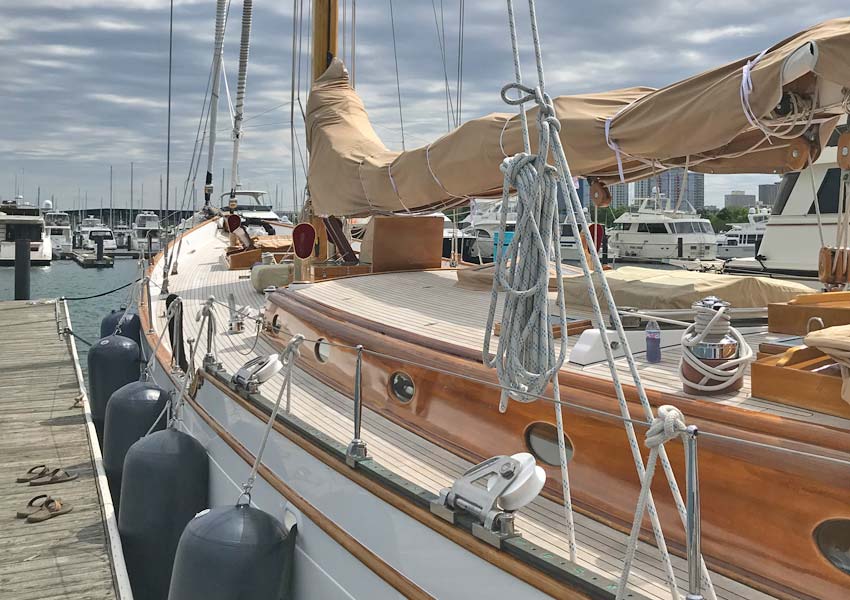

It was recently bought by Peter Thornton who owned Il Mostro (Puma V70), on which Justin Slattery and Willie Lynch were regular crew.
Despite the distance from this island, The Mac has longstanding Irish connections. In 2002, the late Roy Disney, who was certainly no stranger to these shores, set the race’s monohull record of 23 hours and 30 minutes in his Maxi Z68, Pyewacket.
Cork's Justin Slattery & Rán Crew Lift the One Ton Cup
Cork's Volvo Ocean Race Winner and super crew Justin Slattery was aboard Niklas Zennstrom's Rán when they won the One Ton Cup at the weekend.
At a ceremony held at the Royal Ocean Racing Club's Cowes Clubhouse. RORC Racing Manager, Chris Stone welcomed Christophe Hinfray representing the owners of the trophy, the Cercle de la voile de Paris. Christophe presented the One Ton Cup to the victorious Rán crew.
“It is a great honour to raise this trophy,” commented Niklas Zennstrom. “It has been really good racing, and personally the reason I joined the class was to win the One Ton Cup. It is such a prestigious trophy, as a kid I was reading about it, and it was certainly something to race for, we are very proud to be winners. On behalf of all the owners, I would like to thank the RORC and the FAST40+ Race team for fantastic organisation, and Peter Morton for sponsoring the regatta and giving us a fantastic party at the start of the regatta. Also for all the sailors for putting up such a good competition.”
Created in 1899 by the Cercle de la voile de Paris (CVP), skippers from 12 nations have won the prestigious One Ton Cup over the last 119 years. Teams from France have won the cup on 13 occasions and British teams have been victorious 14 times. Niklas Zennstrom racing Rán in the 2018 edition has become the fifteenth Swedish skipper to win the One Ton Cup. The last Swede to win the One Ton Cup was Claës-Henrik Nordenskiöld's May Be VIII in 1959, long before any of the Rán crew were born.
Rán crew: Niklas Zennstrom, Tim Powell, Adrian Stead, Steve Hayles, Justin Slattery, Toby Iles, Connor Banks, Hamish Macdonald, Silas Nolan, Ellie Cumpsty, Tom Needham.
Going into the last day of the regatta, Rán had a huge lead of the competition. In the penultimate race, Rán was leading the fleet but hit the top mark and finished the race in tenth place. Bas de Voogd's Hitchhiker took the race win, to come within one point of challenging Peter Morton's Girls on Film for second place. Mike Bartholomew's Tokoloshe II was third scoring their second podium position for the regatta.
Rán finished the regatta in style scoring their sixth bullet in the nine-race series to win the Wight Shipyard One Ton Cup. Girls on Film finished Race 9 in second place to hold off Hitchhiker into third for the series. Stewart Whitehead's Rebellion scored consistently throughout the regatta to finish fourth, and Tony Dickin's Jubilee covered Tokoloshe II in the last race to secure fifth place for the Wight Shipyard One Ton Cup.
How Much in the Sponsorship Pot for all These Irish Offshore Sailing Superstar Hopefuls?
There have been several Irish offshore racing sailors who have been making national and world headlines for some years now, but in recent weeks and months the wave of new enthusiasm for the big ticket events has surged to fresh heights.
One of the stories underlying all this is the potential for a specialist marine industry base in Cork Harbour serving the continuous needs of the most advanced racing machines, and providing a launch pad for global campaigns. The idea has been around for some time now, but as reported in Afloat.ie as long ago as April 1st 2015, while the goodwill may be there, a firm decision is still awaited.
Local minister Simon Coveney has since moved on from the Marine to other Government departments. His present very senior role in representing Ireland through the Department of Foreign Affairs in decidedly turbulent times will mean that the needs of something so difficult to gauge for significant political and economic benefits will scarcely be top priority.
Yet for the many leading Irish sailors – both men and women – who have launched themselves into the decidedly uncertain world of top level professional competition, the problem of resources and facilities to keep the show on the road is always present, and frequently at crisis levels. W M Nixon wonders how there is going to be enough in the sponsorship pot – both nationally and globally – to help them all fulfill their dreams.
On Tuesday, Afloat.ie received confirmation of a “virtual press conference” in Cork, in other words a clearcut announcement that Nin O’Leary’s co-skippering of the IMOCA 60 Hugo Boss with Alex Thompson was going to move on to a full-blooded Vendee Globe campaign by O’Leary himself, possibly with a new boat.
 The then Minister for the Marine Simon Coveney, Hugo Boss skipper Alex Thomson, and Stewart Hosford at the announcement in Cork in 2015 of a possible international offshore racing hub on Haulbowline Island.
The then Minister for the Marine Simon Coveney, Hugo Boss skipper Alex Thomson, and Stewart Hosford at the announcement in Cork in 2015 of a possible international offshore racing hub on Haulbowline Island.
In the meantime, the word on the waterfront is that the two skippers may do the two-handed Barcelona World Race 2018 in the current boat. But beyond that, the campaign plan for the charismatic O’Leary, mentored by Thomson and orchestrated by Stewart Hosford, is rumoured to be the building up of enough resources to keep this boat, yet also build a new one.
This is because the boat is still almost state-of-the-art, she has some features still absent in other boats, and could be serious opposition in someone else’s hands. Thus the ideal scenario is to maintain control of their current technology and design, while moving on to the next stage of development with an even more advanced boat for the Vendee Globe in 2020.
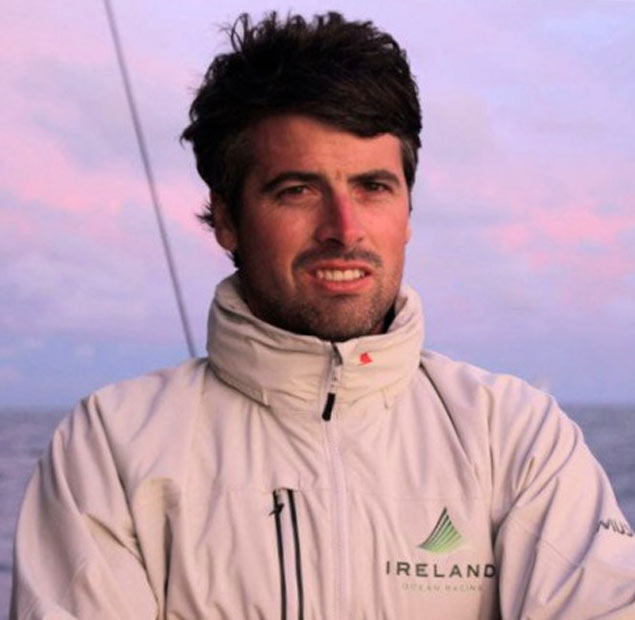 Nin O’Leary – a charismatic figure for Ireland’s younger sailors
Nin O’Leary – a charismatic figure for Ireland’s younger sailors
We’re talking mega-bucks here, and the relationship with Hugo Boss has been very fruitful, but the elephant in the room - which hasn’t been mentioned yet - is how long will the Hugo Boss sponsorship continue?
This may all become clearer within the next ten days, as Thomson, O’Leary and Hugo Boss are headed for Ireland, with Cork in their sights on Monday 28th and Tuesday 29th August, and then they’re in Dun Laoghaire for a very public appearance on Wednesday August 30th, and staying until the Friday, September 1st for the ongoing launch of their new brand Ireland Ocean Racing.
This puts them top of the billboards. But we mustn’t let it blind us to the hopes of other campaigners, and on Thursday of this week, Tom Dolan made his final public appearance in Ireland before returning to France for the countdown towards the start of the Mini Transat 2017 from La Rochelle at the beginning of October.
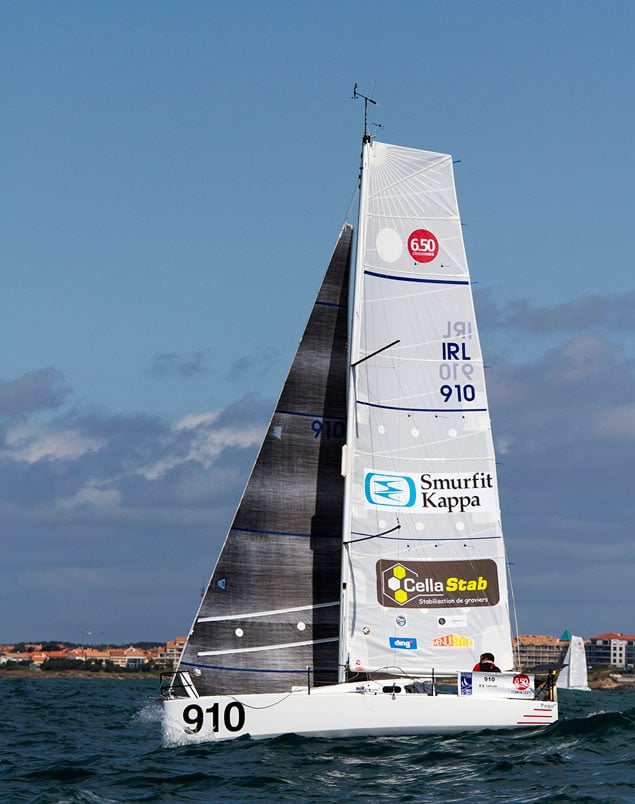 Although Tom Dolan has some sponsorship for IRL 910, there is still a shortfall in funding for the Mini Transat 2017 which starts at the beginning of October from La Rochelle
Although Tom Dolan has some sponsorship for IRL 910, there is still a shortfall in funding for the Mini Transat 2017 which starts at the beginning of October from La Rochelle
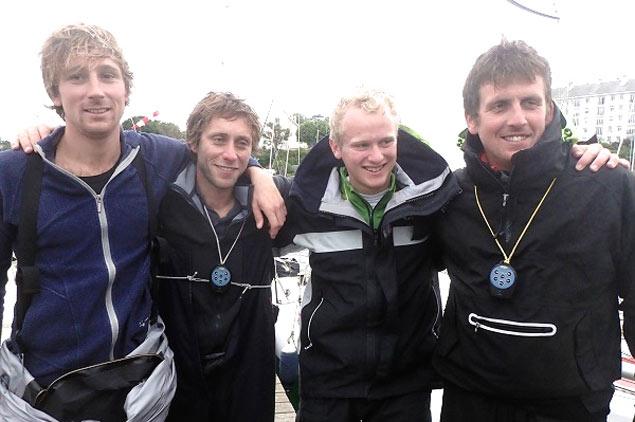 Tom Dolan (right) and fellow skippers in the Mini 650 class at Concarneau. The camaraderie and mutual help among the sailors contributes to France’s dominant position in short-handed sailing
Tom Dolan (right) and fellow skippers in the Mini 650 class at Concarneau. The camaraderie and mutual help among the sailors contributes to France’s dominant position in short-handed sailing
Although Tom has some support backers whose logos appear on his sails, he makes no bones about his overall situation, as his Pogo 3, IRL 910, currently enters races under the name of “Still Seeking a Sponsor”. Whether his presentation in the National YC on Thursday will turn on any money taps in Ireland remains to be seen, the fact is that it’s in France he makes most impact. But in Dun Laoghaire, his burning enthusiasm left an abiding impression, for although his chosen life-path may be more exciting than running the small family farm in Meath, there are times when it’s a massive struggle.
Tom is one of several Irish international offshore wannabees and established skippers who have made a point of having the cup of coffee with Marcus Hutchinson. Hutchinson has transformed himself from being a young sailor who first learned his craft in Howth into an international sailing campaign management figure who maintains his Irish connections through Kinsale, yet is now a key presence at the French-led cutting edge of specialist offshore programmes.
 Marcus Hutchinson is first Port of Call for anyone seriously contemplating a short-handed offshore campaign
Marcus Hutchinson is first Port of Call for anyone seriously contemplating a short-handed offshore campaign
It’s rumoured that in Brittany he has access to a large warehouse full of IMOCA 60s and Open 40s and whatnot. What we do know for sure is that he was very much the background force in Paul Meilhat’s stunning victory in the IMOCA 60 SMA in the recent Rolex Fastnet Race, a neatly-read campaign whose success was highlighted by the inescapable fact that Hugo Boss finished eighth out of the nine IMOCA 60s competing.
SMA with her dagger boards was optimized for windward work, whereas Hugo Boss with her foils most emphatically wasn’t. But while those in the know are aware of this, Joe Public simply sees the final results and takes it from there.
 The Marcus Hutchinson-managed SMA was convincing winner of the IMOCA 60 Class in the Rolex Fastnet Race 2017. Photo: Carlo Borlenghi
The Marcus Hutchinson-managed SMA was convincing winner of the IMOCA 60 Class in the Rolex Fastnet Race 2017. Photo: Carlo Borlenghi
Marcus Hutchinson’s deep well of sound advice is available to those who seek him out, and he is generous with his knowledge and sensible thoughts. Talking to Afloat.ie yesterday morning, he made the point that of the current wave of French superstars in the bigger boats, many have done the Figaro Solo at least a dozen times, and he reckons that setting out to take on the Vendee Globe straight from a career – however successful – in fully-crewed boats, is akin to taking on Everest solo without first trying a few smaller mountains on your own.
The list of those specialist sailors from Ireland who have made a point of seeking advice and assistance at some stage from Marcus Hutchinson is both impressive and fascinating, as it includes Damian Foxall, Justin Slattery, Enda O'Coineen, David Kenefick, Joan Mulloy, Sean McCarter, Tom Dolan and most recently Conor Fogerty.
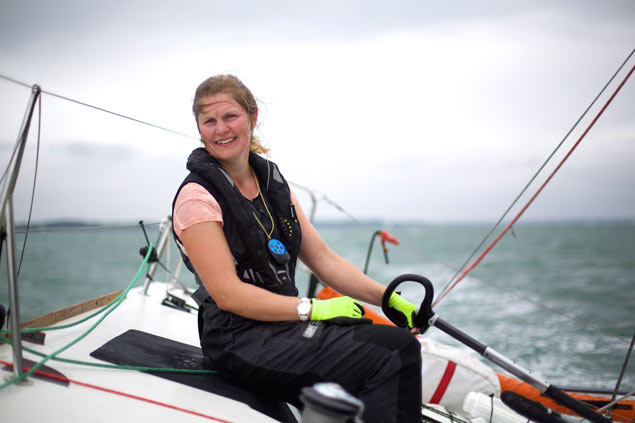 Joan Mulloy of Westport in County Mayo has secured a Figaro through Marcus Hutchinson, but still requires sponsorship
Joan Mulloy of Westport in County Mayo has secured a Figaro through Marcus Hutchinson, but still requires sponsorship
 David Kenefick of Cork is another solo sailor who was guided into the Figaro Class by Marcus Hutchinson
David Kenefick of Cork is another solo sailor who was guided into the Figaro Class by Marcus Hutchinson
And a salient fact which emerges in talking to some of them is the thought that while the Alex Thomson/Hugo Boss campaign was impressive, its central ethos of being stand-alone was ultimately counter-productive.
Two of the lone skippers mentioned above went so far as to say that if the Hugo Boss campaign had been prepared to mix it a bit more with the strongholds of French single-handed sailing in Brittany, then they would have won the Vendee Globe instead of coming second.
That’s undoutedly one for the speculation mill. But it gets a certain reinforcement from a statement this week from Nin O’Leary, to the effect that moving the base from Portsmouth to Cork would have the beneficial result of making the major French centres seem more accessible, as there’s almost a feeling of being trapped in the Eastern Solent, whereas in Cork it’s open water – and open thinking - all the way to Ushant and beyond.
This desire for open water and open thinking is spreading. One of the most interesting news items of recent weeks was that Olympic Silver Medallist Annalise Murphy hoped to secure a berth aboard Dee Caffari’s Volvo 65 for the up-coming Volvo World Race. Unfortunately the knee injury Murphy exacerbated with a spectacular capsize at the conclusion of becoming the International Moth Women’s World Champion 2017 on Lake Garda has put that idea on hold, but this shift of interest from the grind of Olympic training on a tedious four year cycle to the more stimulating world of big-time offshore stuff, with maior events coming up in rapid succession, reflects a discernible pattern of changing public awareness.
 The new Volvo 65 Turn the Tide on Plastic. Olympic Silver Medallist Annalise Murphy had to defer taking up a berth on Dee Caffari’s Volvo 65 because of a knee injury sustained during a capsize in the Moth Worlds at Lake Garda
The new Volvo 65 Turn the Tide on Plastic. Olympic Silver Medallist Annalise Murphy had to defer taking up a berth on Dee Caffari’s Volvo 65 because of a knee injury sustained during a capsize in the Moth Worlds at Lake Garda
So Olympic sailing, ever mindful of the need to continue to attract public attention by whatever means, is going to include a test offshore series, probably for two person boats, in the Tokyo Olympics in 2020.
This is of particular interest to any Irish sailor desperately seeking sponsorship, for the reality is that on our island, there are only half a dozen sports – if that - which are big enough to make an impact on their own. The minority sports - sailing included - only figure significantly in public awareness if they come up in the Olympic searchlight.
That Olympic searchlight in turn encourages others to get involved, thereby stretching the cloak of sponsorship ever thinner. So it will be some time, if ever, before we see a joint approach to the challenge of raising sponsorship for this branch of sailing. And Heaven knows, but it’s difficult enough to get an effective short-handed sailing campaign of international standard up to speed without the endless worry of finding the money. Yet that’s the way it is. But if you really do find the challenge irresistible, Afloat.ie’s advice is to make arrangements to have a cup of coffee with Marcus Hutchinson before you do anything else.
Cork Offshore Sailor Justin Slattery Breaks Transpacific Record With One Hour To Spare
County Cork's Justin Slattery onboard Lloyd Thornburg's Phaedo3 swept past Diamond Head Lighthouse buoy at 4:32:18am local time in Hawaii today, to shave an hour off the previous record Transpacific record. The total elapsed time was 3 days, 16 hours 52 minutes and 03 seconds (all times are still to be ratified by the WSSRC).
As Lloyd stepped onto the dock he said.... “ An unbelievable trip! Can't believe we actually broke the record! This was the most difficult sail of my life. Everything went our way and the team put out a super human effort in order to keep the boat moving at nearly 30 knots through the entire trip. We are all excited for a well deserved rest and some sight seeing in Hawaii..."
As Afloat.ie reported previously, crew on board for the record–breaking run were: Lloyd Thornburg, Brian Thompson, Fletcher Kennedy, Justin Slattery, Pete Cumming, Henry Bomby and David Swete.


























